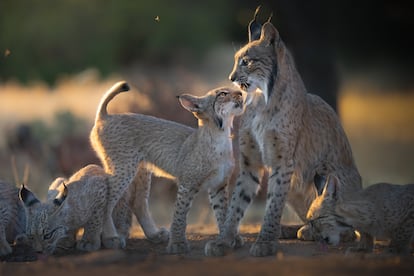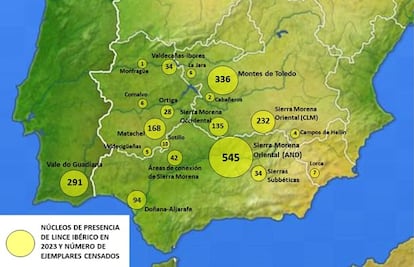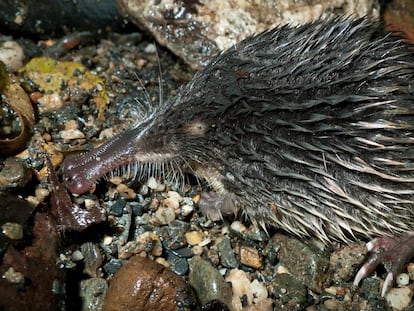The Iberian lynx doubles its population in just three years and reaches 2,000 individuals
Despite the good data, 344 more breeding females are still needed for the species to reach a favorable status

The Iberian lynx (Lynx pardinus) continues along its upward path, although it is still at risk of extinction. The last census in 2023 shows that the species has doubled its population in the last three years and has reached 2,021 individuals, with 1,299 adults or subadults and 722 cubs. Despite the good data, 750 breeding females would be needed to classify the species in a favorable conservation status, and in this latest count only 406 have been detected. According to Spain’s Ministry for the Ecological Transition, they are “gradually” getting closer to the necessary number, but are still falling short.
Captive breeding centers have played an essential role in this recovery. From 2011 to 2023, 372 lynxes born in the four existing centers have been released. The population has been expanding, and last year the reproduction of the species was verified in 14 population centers, in addition to the stable presence in new areas of the Spanish region of Murcia, and the provinces of Albacete, Badajoz, Toledo and Ciudad Real. Most of the specimens, 1,731 or 85% of the total, live in Spain and the rest, 291, are in Portugal. The stable populations are located in four Spanish regions: Andalusia with 755 specimens (43.6% of the Spanish population), closely followed by Castilla-La Mancha with 715 lynxes (41.3%), Extremadura where 253 specimens were located, and Murcia with seven.

The ministry believes that the data allow for a degree of optimism, because the feline’s trend is positive and has continued on an upward trend since 2015, the year in which the International Union for Conservation of Nature (IUCN) lowered its threat level. The species went from being “critically endangered” to simply “endangered.” It was a fundamental step for the survival of an animal that was close to extinction in 2002, when only 94 specimens remained in Andalusia. Captive breeding programs with significant European investment have allowed the creation of different nuclei, and have managed to reverse the situation. This increase now means that lynxes are approaching inhabited places, as happened in late March, when a rancher found four lynxes born in his haystack in Menasalbas, municipality of Toledo.
“We are at an average growth of 20%, a trend that has been maintained due to the creation of three new nuclei,” says Ramón Pérez de Ayala, a member of World Wildlife Fund (WWF) and a specialist in the species. To obtain the number of breeding females, it is necessary, according to their calculations, to create another five new areas with lynxes. “There were populations that grew a lot, up to 30%, but then they stabilized,” he explains. This occurred in the mountains of Toledo, one of the biggest success stories of reintroduction. “There, the first place where they became active was practically saturated, but the lynxes have moved to a neighboring area, which has kept up the growth,” he notes. The same situation has taken place in other areas such as Guarrizas (Jaén) and in Portugal, in the Guadiana valley area.
A reproductive female needs a territory of about 500 hectares, although it all depends on the amount of food available: the more food there is, the less space is needed. The rabbit is the main component of their diet and there are places where the rabbit population cannot recover, affected mainly by a deadly hemorrhagic disease. Depending on the areas, the drop is between 30% and 87% in a decade, indicates Pérez de Ayala. In this boom situation, the feline’s biggest enemy is road accidents, which has become its main cause of mortality. “In 2023 there were 144 deaths due to this cause, 7.1% of the population, and we cannot forget poaching, which goes unnoticed.”
Sign up for our weekly newsletter to get more English-language news coverage from EL PAÍS USA Edition
Tu suscripción se está usando en otro dispositivo
¿Quieres añadir otro usuario a tu suscripción?
Si continúas leyendo en este dispositivo, no se podrá leer en el otro.
FlechaTu suscripción se está usando en otro dispositivo y solo puedes acceder a EL PAÍS desde un dispositivo a la vez.
Si quieres compartir tu cuenta, cambia tu suscripción a la modalidad Premium, así podrás añadir otro usuario. Cada uno accederá con su propia cuenta de email, lo que os permitirá personalizar vuestra experiencia en EL PAÍS.
¿Tienes una suscripción de empresa? Accede aquí para contratar más cuentas.
En el caso de no saber quién está usando tu cuenta, te recomendamos cambiar tu contraseña aquí.
Si decides continuar compartiendo tu cuenta, este mensaje se mostrará en tu dispositivo y en el de la otra persona que está usando tu cuenta de forma indefinida, afectando a tu experiencia de lectura. Puedes consultar aquí los términos y condiciones de la suscripción digital.
More information
Archived In
Últimas noticias
Most viewed
- Reinhard Genzel, Nobel laureate in physics: ‘One-minute videos will never give you the truth’
- Pablo Escobar’s hippos: A serious environmental problem, 40 years on
- Charles Dubouloz, mountaineering star, retires at 36 with a farewell tour inspired by Walter Bonatti
- Why we lost the habit of sleeping in two segments and how that changed our sense of time
- The fall of a prolific science journal exposes the billion-dollar profits of scientific publishing











































